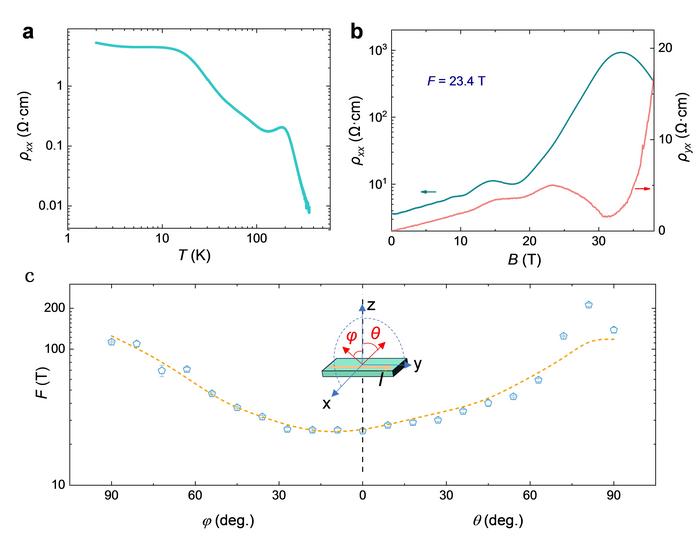
A groundbreaking discovery has emerged from the collaborative efforts of physicists studying quantum materials, particularly around the Mott-Ioffe-Regel (MIR) limit. This research shines a light on the mysterious behaviors of metals that challenge long-standing theories in condensed matter physics, specifically the transition from metallic to insulating behavior as the mean free path of quasiparticles approaches the Fermi wavelength. The findings indicate that the conventional understanding of electron transport may not adequately account for the complexities of electron coherence near this crucial threshold.
The MIR limit posits that as quasiparticles attempt to traverse a material, their transport mechanism transitions from diffusive to hopping conduction as their mean free path dwindles. This transition is expected to suppress coherent quantum movements due to interactions with lattice structures, leading to an insulating state. However, recent experiments conducted on single crystals of CaAs3 have raised intriguing questions about this theory, suggesting that a significant level of electron coherence can persist even in systems approaching the MIR limit.
In a meticulous study led by Professors Cheng Zhang and Faxian Xiu alongside Professor Xiang Yuan, a concerted effort was made to investigate the electronic properties of CaAs3 under extreme conditions of low temperature and strong magnetic fields. By leveraging sophisticated high magnetic field facilities, the researchers were able to apply magnetic fields up to 45.22 Tesla and probe quantum transport phenomena. Their experimental setup was crucial in observing quantum oscillations and examining the underlying electronic structures of CaAs3.
The results were both surprising and revealing. The longitudinal resistivity of CaAs3 exhibited an insulator-like dependency on temperature, which was expected as the system approached the MIR limit. However, alongside this insulating behavior, the study found clear signatures of Shubnikov-de Haas oscillations in the magnetoresistance measurements. This indicated that the electronic carriers in the material are capable of coherent band transport, defying expectations of hopping transport associated with traditional theories of localized states.
Equally compelling were the observations related to the Hall and Seebeck coefficients, which displayed unusual sign reversals at low temperatures. These phenomena suggested that, contrary to standard theories predicting behavior based solely on localized electron states, significant mobility and coherence were present above certain energy thresholds within the material. Such findings invite a reevaluation of the mechanisms governing metallicity in materials at the boundary established by the MIR limit.
The research team undertook extensive magneto-infrared spectroscopy studies, which corroborated the existence of Landau quantization through observed interband-Landau-level transitions. This multifaceted approach allowed researchers to derive critical parameters such as effective mass and Fermi velocity, revealing a pronounced band renormalization effect near the Fermi level of CaAs3. Beyond mere parameters, these results highlighted the intricate electronic interactions that occur as the material approaches the MIR limit.
Through a powerful analytical lens, the research team employed a two-fluid model to interpret their findings. This model proposes that the electronic properties observed can be attributed to a delicate interplay between the mobility edge and van Hove singularities, whereby the contributions to quantum oscillations stem from mobile electrons existing above the mobility edge. In contrast, the insulating state characterized by resistive behavior is dominated by localized electrons beneath this edge. This duality provides a remarkable insight into the complex nature of quasiparticle dynamics in strongly correlated systems.
The implications of this research extend beyond the confines of CaAs3, as they pose fundamental questions about the nature of metallicity in various materials exhibiting unconventional behaviors. As scientists venture deeper into understanding these phenomena, advancements in quantum materials may lead to innovative applications in electronics and quantum computing that leverage the unique properties of electrons within these complex systems.
Much work remains to be done to fully comprehend the ramifications of electron coherence near the MIR limit. The research opens new conceptual pathways for exploring strange metal phases, including the critical nature of temperature-dependent resistivity and its implications for superconductivity. As investigations in this field deepen, a clearer understanding of the quantum properties that underpin new electronic states will inevitably unfold, potentially leading to breakthroughs in material science and quantum physics.
Overall, this collaborative study illuminates the complexities surrounding electron transport mechanisms in quantum materials. The discovery that CaAs3 exhibits strong electron coherence despite being near the MIR limit challenges conventional paradigms and suggests a need for revised models in theoretical physics. The research provides a fascinating glimpse into the subtleties of phase transitions in strongly correlated electron systems that merit ongoing investigation and exploration.
Subject of Research: Anomalous Electron Coherence in CaAs3
Article Title: Observation of Quantum Oscillations near the Mott-Ioffe-Regel Limit in CaAs3
News Publication Date: 2024
Web References: 10.1093/nsr/nwae127
References: National Science Review
Image Credits: ©Science China Press
Keywords
Physical sciences, Quantum limits, Magnetic fields, Electron theory of metals, Electronic coherence, Discovery research, Quantum oscillations, Quantum mechanics, Mechanics, Physics.





